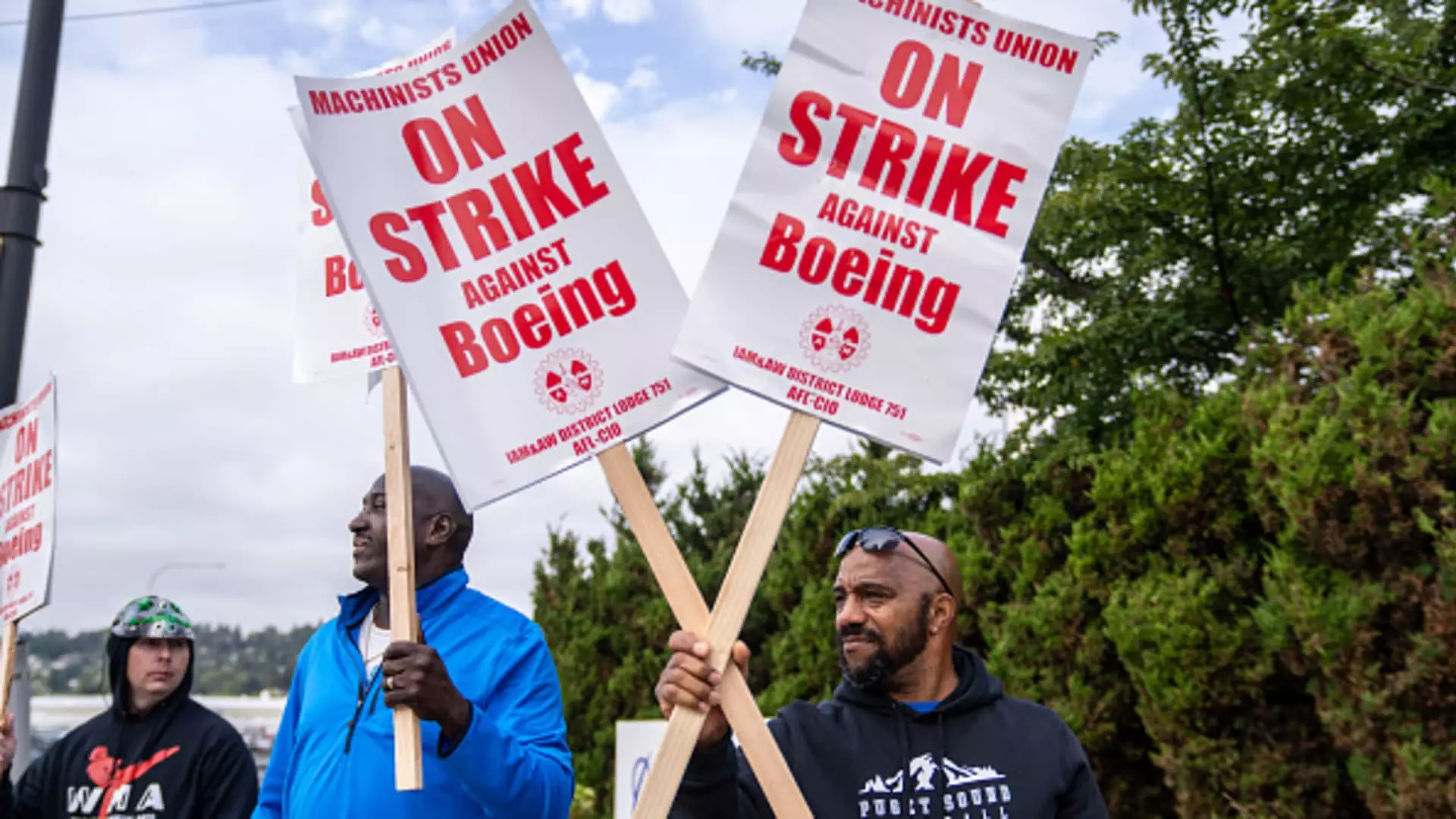In recent weeks, Boeing has found itself embroiled in a significant strike led by its machinists, which has disrupted operations and exacerbated the company’s ongoing struggles. Over 30,000 members of the machinists union walked off their jobs after rejecting a tentative contract, revealing profound dissatisfaction among workers. The strike is not only a defining moment for the employees but also a daunting challenge for Boeing’s new CEO, Kelly Ortberg, who assumed control over the summer amidst a haze of troubles that have loomed over the company for years.
The scope of the strike is staggering, with S&P Global Ratings estimating that it costs Boeing over $1 billion every month. This financial toll comes at a particularly bad time, as the company has already grappled with a series of crises, including the infamous 737 Max door plug incident and the fallout from two fatal crashes. The ongoing labor unrest further deprives Boeing of much-needed cash flow and threatens its industrial stability, creating a precarious situation for the company as it attempts to navigate a crowded and competitive aerospace landscape.
Despite initial optimism regarding a negotiated agreement, the atmosphere around the negotiations has soured significantly. Following the machinists’ decisive rejection of the proposed labor deal, Boeing attempted to offer a sweeter deal, which was also turned down. The breakdown in negotiations has heightened tensions, as union representatives have accused Boeing of negotiating in bad faith. This has led to a deadlock that leaves workers without paychecks and benefits during the strike.
Jon Holden, president of the shop floor union, is calling for renewed negotiations, emphasizing the necessity for a collaborative approach to resolve the impasse. He remarked that Ortberg has the potential to lead a shift away from adversarial labor relations tactics that often hinder constructive dialogue. Holden’s comments underline the urgent need for equitable resolutions, as workers are facing not just loss of pay but also the deterioration of their overall work conditions.
However, industry experts suggest that the union’s request for the reinstatement of a pension plan is increasingly unrealistic. Harry Katz, a labor relations expert, predicts that the strike could endure for several weeks longer, suggesting a protracted battle ahead.
As Boeing grapples with production halts, the company has announced plans to reduce its global workforce by approximately 10%. This decision includes layoffs across various levels of management and direct operations, highlighting the company’s ongoing financial woes. In a surprising twist, Ortberg revealed that the production of the commercial 767 freighters will cease in 2027, with further delays anticipated for the 777X, pushing deliveries back to 2026.
Alongside these operational changes, Boeing expects substantial losses, forecasting nearly $10 per share for the third quarter and incurring approximately $5 billion in charges. This scenario raises alarms as Boeing has not reported an annual profit since 2018, drawing into question the management’s strategy moving forward. Critics suggest that instead of fostering stability, the company’s recent decisions may hinder its recovery efforts, indicating a potential miscalculation in their approach to labor and finances.
Boeing’s turmoil does not occur in isolation; it sends shockwaves through the broader aerospace supply chain. Suppliers, like Spirit AeroSystems, are already contemplating potential furloughs in response to Boeing’s production issues. The ripple effects of Boeing’s labor strife underscore a growing instability that could impact not just the company’s bottom line, but also the job security of thousands of workers in related sectors.
Analysts caution that if Boeing continues to face operational and financial difficulties, it may jeopardize relationships with suppliers and stymie innovation. Richard Aboulafia, an aerospace analyst, argues that to stabilize production, the company must prioritize reinstating the workforce that is crucial to getting operations back on track. However, the juxtaposition of layoffs against the backdrop of these pressing needs feels contradictory.
The significance of resolving the labor crisis cannot be understated; doing so may well be the key to Boeing’s future. Ortberg’s leadership will be critical as he faces investors and attempts to communicate a roadmap for recovery. The forthcoming earnings call offers an opportunity for the CEO to articulate a clear vision amidst uncertainty. While Boeing’s past missteps have left it vulnerable, the path to recovery runs through effective negotiation and repairing relationships with its workforce.
Boeing’s ongoing challenges symbolize a broader struggle within the aviation industry that is marked by labor disputes, financial hardship, and the quest for renewal. The resolution of the strike will determine not only the immediate future of Boeing as a company but may also redefine labor relations in the aerospace sector, setting precedents for how similar disputes are handled going forward. Time will tell if Ortberg can steer Boeing back to stability, but the stakes have never been higher.

